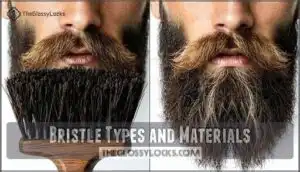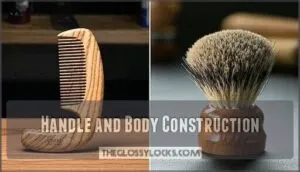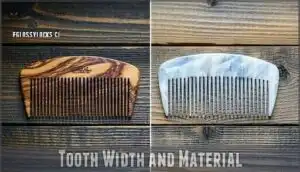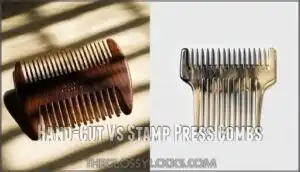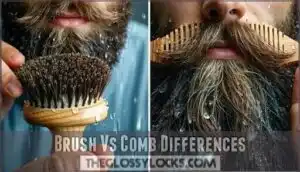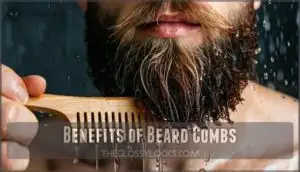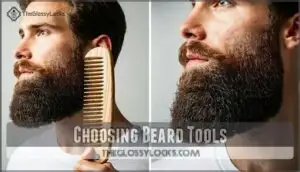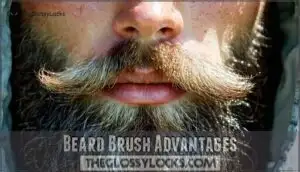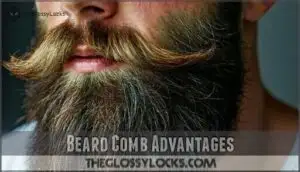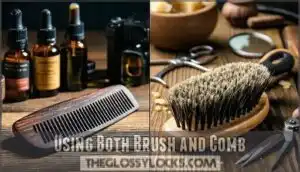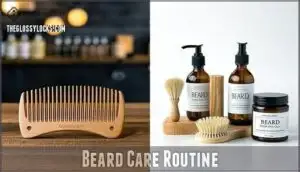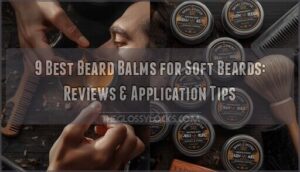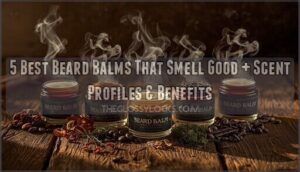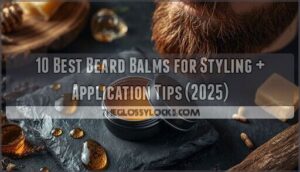This site is supported by our readers. We may earn a commission, at no cost to you, if you purchase through links.

Brushes use densely packed bristles to spread natural oils from your skin throughout your facial hair, creating that healthy shine while training stubborn hairs to grow in the right direction.
Combs, with their rigid teeth, excel at detangling knots and giving you surgical precision for detailed styling work.
Your beard’s length and thickness determine which tool you’ll reach for first, though most seasoned groomers discover that combining both creates the ultimate grooming arsenal for maximum control and results.
Table Of Contents
- Key Takeaways
- Beard Brush Basics
- Beard Comb Features
- Brush Vs Comb Differences
- Benefits of Beard Brushes
- Benefits of Beard Combs
- Choosing Beard Tools
- Beard Brush Advantages
- Beard Comb Advantages
- Using Both Brush and Comb
- Beard Care Routine
- Frequently Asked Questions (FAQs)
- Is it better to brush or comb your beard?
- Is it better to use a comb or brush?
- Should guys use a comb or brush?
- When should I start using a beard brush?
- How often should I replace my beard tools?
- Can beard brushes cause hair breakage or damage?
- Whats the ideal grooming routine timing and frequency?
- Do expensive beard tools perform significantly better?
- Should I use different tools for different seasons?
- Conclusion
Key Takeaways
- You’ll get better results using both tools together – brushes excel at distributing natural oils and training shorter beards, while combs provide precision detangling and styling for longer facial hair.
- Your beard’s length determines which tool to prioritize – if you’ve got a short beard under three inches, reach for the brush first; for longer beards, start with a comb to work through tangles before styling.
- Brushes boost your beard’s health through skin stimulation – the bristles naturally exfoliate dead skin cells, increase blood circulation to follicles, and prevent beard dandruff while distributing oils from root to tip.
- Combs give you surgical precision for styling and wet grooming – their rigid teeth let you safely detangle damp hair after showering, apply products evenly, and create defined shapes that brushes can’t achieve.
Beard Brush Basics
A beard brush consists of bristles attached to a wooden or synthetic handle, designed specifically to distribute natural oils throughout your facial hair while exfoliating the skin beneath.
You’ll find these grooming tools equipped with natural boar bristles, horsehair, or synthetic fibers, each offering different benefits for maintaining and styling your beard’s appearance, which involves exfoliating the skin.
Bristle Types and Materials
Natural boar bristles reign supreme for your beard brush, effectively distributing oils while reducing frizz through their flexible yet firm structure.
Synthetic bristles offer vegan options but lack the oil-distributing prowess of boar hair.
You can find a quality bristle brush for your grooming needs.
Bristle stiffness matters—too soft loses control, too stiff damages skin, and material durability depends on quality, with natural bristles typically outlasting their synthetic counterparts in performance.
Handle and Body Construction
When you’re examining beard brush construction, the handle and body materials directly impact your grooming experience.
Most quality brushes feature wood construction like pearwood or beechwood, offering superior material durability compared to plastic alternatives.
The handle ergonomics determine your grip comfort during daily use, while size variation affects portability and control.
- Wood construction provides long-lasting durability and natural feel
- Ergonomic handle design guarantees comfortable grip during grooming sessions
- Size variation ranges from travel-friendly to full-size options
- Material durability affects longevity and performance over time
- Construction impact influences bristle retention and overall quality
Bristle Length and Beard Type
Your bristle choice depends entirely on your beard length and styling needs.
Short beard owners benefit from shorter, stiffer bristles that grip hair effectively. Long beard enthusiasts need longer, flexible bristles to penetrate thick growth.
Bristle stiffness and density matters too—dense bristles offer control while softer ones prevent damage.
| Beard Type | Bristle Length | Best Choice |
|---|---|---|
| Short beard | Short bristles | High density |
| Medium beard | Medium bristles | Balanced stiffness |
| Long beard | Long bristles | Flexible bristles |
Beard Comb Features
When you’re selecting a beard comb, you’ll discover that tooth width, construction method, and material choice directly impact your grooming experience and results.
Understanding these key features helps you choose the right comb for your specific beard type, whether you’re managing a short stubble or a full, lengthy beard.
Tooth Width and Material
Your beard comb’s tooth width determines its effectiveness.
Wide teeth work better for thick, coarse beards, while narrow teeth suit softer, shorter facial hair.
Comb material benefits vary substantially – wood and cellulose acetate offer static reduction and durability, while plastic options remain affordable.
Consider exploring different beard comb materials for ideal grooming.
Material durability affects longevity, with horn and acetate combs lasting longer than basic plastic alternatives.
Hand-Cut Vs Stamp Press Combs
Manufacturing differences between handcut and stamp press combs dramatically impact your grooming experience.
Handcut combs feature individually sawed and polished teeth that glide smoothly through facial hair, while stamp press alternatives often contain microscopic jagged edges that snag and damage follicles.
Key Manufacturing Differences:
- Tooth smoothness – Handcut teeth are painstakingly polished versus rough stamp press edges
- Durability comparison – Handcut construction lasts longer than mass-produced alternatives
- Cost analysis – Premium handcut combs cost more but deliver superior performance
- User experience – Smooth handcut teeth prevent snagging and hair breakage
- Construction quality – Individual cutting process guarantees firm, stable teeth alignment
Comb Size and Portability
Most beard combs come in standard and travel-size options, with pocket combs measuring around 4-5 inches for easy portability.
Travel combs offer significant size benefits when you’re grooming on-the-go, fitting comfortably in your wallet or jacket pocket.
Unlike a bulky beard brush, these compact comb dimensions make them ideal portability factors for frequent travelers who prioritize convenient beard grooming anywhere, with easy portability being a key advantage.
Brush Vs Comb Differences
You’ll notice that beard brushes use flexible bristles to distribute oils and train hair direction, while combs feature rigid teeth designed for detangling and precise styling.
These fundamental design differences mean brushes work best for shorter beards and daily maintenance, whereas combs excel at managing longer facial hair and wet grooming sessions.
Bristles Vs Teeth
The fundamental difference between these grooming tools lies in their working components.
Your beard brush bristles flex and bend, creating a gentler grooming action that massages skin while distributing oils.
Meanwhile, beard comb teeth remain rigid and fixed, providing superior detangling power through precise control and consistent teeth spacing for targeted styling results.
| Feature | Beard Brush Bristles | Beard Comb Teeth |
|---|---|---|
| Flexibility | Bend and flex during use | Rigid and fixed position |
| Bristle Stiffness | Variable, softer touch | Consistent, firm grip |
| Material Impact | Natural fibers distribute oils | Hard materials detangle effectively |
| Grooming Action | Massaging, spreading motion | Precise, separating movement |
Oil Distribution and Detangling
Different tools excel at specific tasks in your beard grooming arsenal.
Brushes dominate oil redistribution through natural bristles that spread sebum effectively, while combs provide superior detangling frequency for longer facial hair.
Product absorption varies substantially between these tools, affecting your beard softness and static reduction results.
| Function | Beard Brush | Beard Comb |
|---|---|---|
| Oil Distribution | Excellent natural sebum spread | Good for applying products |
| Detangling | Best for shorter beards | Superior for longer beards |
| Product Absorption | Distributes oils effectively | Spreads balms and butters |
| Static Reduction | Natural bristles reduce frizz | Wooden combs minimize static |
Beard Length and Type
Your beard length and type determine which tool serves you best.
Short beards under three inches respond better to brushes, while long beards need combs for detangling.
Coarse hair requires wider comb teeth, fine hair needs gentler brush bristles. A key factor is that bristle material matters when choosing a brush.
| Beard Type | Best Tool | Why It Works |
|---|---|---|
| Short Beard | Brush | Distributes oils effectively |
| Long Beard | Comb | Detangles without breaking |
| Coarse Hair | Wide-tooth comb | Reduces pulling and damage |
| Fine Hair | Soft brush | Gentle on delicate strands |
| Curly Beards | Both tools | Comb detangles, brush shapes |
The choice between a comb and a brush depends on understanding your beard’s specific needs, including its length, type, and the coarse or fine nature of your hair.
Benefits of Beard Brushes
You’ll discover that beard brushes offer three primary advantages that make them essential tools for proper facial hair care.
These tools excel at distributing natural oils throughout your beard, training hair to grow in your desired direction, and providing gentle exfoliation that keeps the skin beneath your beard healthy and irritation-free.
They are particularly useful for distributing natural oils, which helps in maintaining a healthy beard.
Oil Distribution and Exfoliation
Your beard brush excels at sebum redistribution, working those natural oils from root to tip like a skilled barber.
This brush exfoliation removes dead skin cells while boosting skin stimulation for better blood flow.
- Distributes beard oil evenly across every strand
- Removes flaky skin through gentle exfoliation
- Stimulates follicles for improved product absorption
- Creates a healthier foundation than any beard comb, which is essential for better blood flow.
Hair Growth and Training
Beyond moisturizing benefits, your beard brush becomes your personal trainer for facial hair.
Daily brushing creates follicle stimulation that encourages healthy growth while training stubborn hairs to follow your desired beard direction.
The bristles work like tiny coaches, guiding growth patterns through consistent training techniques that improve beard blood flow and promote stronger, more manageable whiskers.
For ideal results, consider brushes with natural boar bristles.
| Training Aspect | Beard Brush Effect | Timeline |
|---|---|---|
| Growth Direction | Guides hairs into desired patterns | 2-4 weeks |
| Follicle Health | Increases blood circulation | Daily improvement |
| Hair Strength | Reduces breakage through conditioning | 1-2 weeks |
| Overall Appearance | Creates fuller, more uniform look | 3-6 weeks |
The benefits of using a beard brush include healthy growth, stronger whiskers, and a fuller appearance.
Regular use can lead to significant improvements in the overall health and appearance of your beard, making it a valuable tool for any beard care routine.
With consistent use, you can train your beard to grow in a desired direction and maintain a uniform look.
Skin Stimulation and Health
Your beard brush becomes a mini massage therapist for the skin beneath your whiskers.
The bristles naturally boost blood flow to hair follicles while providing gentle exfoliation that removes dead skin cells and prevents ingrown hairs.
This daily skin stimulation promotes healthier follicle function and reduces irritation that commonly plagues bearded men.
- Enhanced circulation strengthens follicle health
- Natural exfoliation prevents beardruff buildup
- Reduced risk of ingrown hairs
- Minimized skin irritation and inflammation
Benefits of Beard Combs
You’ll find that beard combs excel at detangling knots and tangles, particularly in longer beards where their rigid teeth provide the precision control you need for effective grooming.
They’re also your go-to tool for wet beard care and detailed styling work, since you can use them safely after showering without causing the damage that brushes might create on damp hair, which makes them ideal for detangling knots and detailed styling.
Detangling and Styling
When knots and tangles turn your beard into a bird’s nest, a beard comb becomes your best friend.
When your beard rebels into chaos, your trusty comb steps in as the hero that saves the day.
Unlike brush training that works gradually, comb precision tackles wet styling and stubborn beard tangles head-on.
You’ll achieve your desired beard shape faster while applying styling products evenly throughout your facial hair.
| Detangling Benefits | Styling Advantages |
|---|---|
| Removes knots without breakage | Creates defined beard shape |
| Works on wet or dry hair | Distributes styling products evenly |
| Separates individual hairs | Allows precise sectioning |
| Reduces frizz and static | Enables detailed grooming work |
Precision and Control
Fine-toothed combs deliver surgical precision when beard styling demands accuracy.
Your beard comb becomes an essential trimming aid, isolating individual hairs for detailed shaping while taming flyaways with surgical control.
Unlike brushes, combs excel at product application in specific sections, allowing targeted beard shaping exactly where you need it.
This precision transforms unruly facial hair into masterfully groomed perfection.
Choosing Beard Tools
When selecting between a beard brush and comb, you’ll need to take into account your specific grooming routine, beard length, and the challenges you face with tangles or styling.
Your choice depends on whether you’re dealing with stubborn knots in longer facial hair or focusing on oil distribution and training shorter beard growth.
Grooming Routine and Goals
Your personal beard grooming approach determines which tool serves you best. Consider your Daily Maintenance schedule and Styling Preferences when building your beard grooming kit.
Routine Consistency matters more than having every gadget.
Think about these Beard Goals when choosing between a beard comb and beard brush:
- Quick morning styling versus detailed Product Application sessions
- Training shorter whiskers or detangling longer growth
- Portable grooming for travel or thorough home routines
- Oil distribution focus or precision beard styling needs
- Budget-friendly single tool or complete beard grooming system
Tangles and Knots
Most tangled beards need different approaches based on knot severity and hair thickness.
Your choice between tools determines success in preventing tangles and minimizing hair breakage during detangling methods.
| Tool | Best For | Technique |
|---|---|---|
| Beard Comb | Severe knots, product buildup | Wide teeth first, narrow teeth finish |
| Beard Brush | Prevention, daily maintenance | Gentle strokes, oil distribution |
| Both Tools | Complete routine | Comb detangles, brush styles |
Beard Brush Advantages
You’ll find that beard brushes excel at distributing your skin’s natural oils throughout your facial hair, creating a healthier and more manageable beard while training stubborn hairs to grow in your desired direction.
The bristles also provide gentle exfoliation that removes dead skin cells and stimulates blood circulation, promoting stronger hair growth and reducing the itchiness that often plagues new beard growers, which can lead to a more comfortable and healthier beard with improved blood circulation.
Natural Oil Distribution
Your beard brush excels at sebum redistribution, working like nature’s own conditioning system.
The bristles grab natural oils from your skin and spread them throughout your facial hair, creating ideal beard hydration.
Unlike a beard comb, brush bristle effectiveness comes from its ability to mimic your scalp’s oil absorption process, which is a natural beard oil distribution that keeps your whiskers soft and healthy without products.
Hair Training and Growth
Your beard brush works like a personal trainer for your facial hair, guiding each strand to grow where you want it.
The bristles stimulate hair follicles through gentle massage, boosting follicle health and encouraging beard density.
Regular brushing can also improve scalp blood flow, which is essential for hair growth.
This training technique teaches stubborn hairs proper hair direction, creating a fuller appearance while promoting natural beard growth through consistent growth stimulation.
Skin Exfoliation and Health
Beyond training your beard’s growth pattern, a beard brush works like a gentle face scrub underneath your whiskers.
The bristles naturally exfoliate dead skin cells while boosting blood circulation to your follicles.
Here’s what proper brushing delivers for your skin:
- Beardruff Control – eliminates flaky buildup before it becomes visible
- Follicle Health – prevents ingrown hairs through gentle stimulation
- Circulation Boost – promotes skin hydration and overall beard health
Beard Comb Advantages
While beard brushes excel at oil distribution, beard combs shine in areas where precision matters most.
Your comb for beard becomes indispensable when detangling knots in longer facial hair, especially after three months of growth.
Unlike brushes that require dry hair, beard comb benefits include safe wet beard use without damage or breakage.
This versatility makes product application smoother, allowing you to work beard oils and balms through damp hair effectively.
For those with sensitive skin, consider cellulose acetate combs to avoid irritation.
Precision styling sets combs apart from their bristled counterparts.
The rigid teeth provide superior control for shaping mustaches and creating defined lines.
Long beard focus is where combs truly dominate – they handle thick, unruly hair that would overwhelm most brushes.
Whether you’re trimming with scissors or working through stubborn tangles, a brush for beard simply can’t match the targeted control a quality beard comb delivers.
Using Both Brush and Comb
You don’t have to choose between a brush and comb when both tools offer distinct advantages for your beard care routine.
Using them together creates a thorough grooming approach that maximizes oil distribution, detangling efficiency, and overall beard health.
You can use these tools to improve your daily routine.
Combining Tools for Optimal Results
You’ve discovered each tool’s strengths, but the real magic happens when you combine them.
Using a beard brush and beard comb together creates synergy benefits that surpass individual results.
Tool sequencing matters: start with your comb to detangle, then follow with the brush for product application.
This ideal regimen adapts to your beard type, maximizing your beard grooming tools‘ effectiveness.
Some find that using sandalwood reduces static when grooming with a beard comb.
Brush and Comb Techniques
Master proper beard brush usage by stroking downward following your hair’s natural growth pattern.
For beard comb usage, maintain a 45-degree comb angle while working through sections systematically.
Apply products before brushing for even distribution. Wet combing works best after showering, while dry brushing trains hair direction.
These beard styling techniques and grooming tips guarantee superior beard training results.
Daily Grooming Routine
Perfect techniques mean nothing without consistent execution.
Your Morning Routine sets the foundation for well-groomed facial hair throughout the day, while Evening Care promotes healthy beard health overnight.
Here’s your daily beard maintenance schedule:
- Morning Routine: Brush dry beard first, then comb with product for styling
- Product Application: Distribute oils evenly using your beard brush’s natural bristles
- Styling Techniques: Shape with comb after brushing for precision control
- Evening Care: Quick brush-through removes daily debris and redistributes oils
- Maintenance Tips: Clean tools weekly, replace worn bristles monthly for superior grooming
Beard Care Routine
You’ll achieve the best results when you establish a consistent grooming routine that incorporates proper tool maintenance, effective techniques, and awareness of common pitfalls.
Understanding how to clean your brush and comb, apply the right grooming methods, and avoid typical mistakes will keep your facial hair healthy and well-styled.
Cleaning and Maintaining Tools
Proper maintenance keeps your grooming tools performing like new.
Your beard brush and beard comb need regular attention to prevent product buildup and maintain hygiene.
You can find a specialized beard cleaner for ideal care.
| Tool | Cleaning Frequency | Method |
|---|---|---|
| Beard Brush | Weekly | Warm water, shampoo, air dry |
| Beard Comb | Weekly wash, monthly sanitization | Soap, toothbrush for teeth |
Store tools in dry areas for superior bristle care and longevity.
Tips for Effective Grooming
Building up your beard care routine requires consistency and the right approach.
Your grooming frequency should match your beard’s growth rate, while proper product application guarantees even distribution of oils and balms.
- Establish a maintenance schedule – groom daily for short beards, every other day for longer ones
- Apply products to damp hair – oils absorb better on slightly wet facial hair
- Use shaping techniques – brush downward first, then style into desired direction
- Check beard symmetry – trim uneven spots weekly to maintain balanced appearance
- Combine beard comb and beard brush – brush distributes oils, comb detangles and styles precisely
Common Mistakes to Avoid
Many beard enthusiasts unknowingly sabotage their grooming efforts through preventable mistakes.
Overbrushing leads to hair breakage, while using dirty tools breeds bacteria. Wrong product choices cause skin irritation, and ignoring skin health creates itchiness.
Understanding these pitfalls helps you maintain healthier facial hair through proper beard care techniques.
| Mistake | Problem | Solution |
|---|---|---|
| Overbrushing daily | Hair breakage and split ends | Brush 2-3 times maximum per day |
| Using dirty tools | Bacteria buildup and infections | Clean beard brush and beard comb weekly |
| Wrong product application | Skin irritation and clogged pores | Match products to your skin type |
| Aggressive detangling | Comb damage and hair loss | Start with wide teeth, work gently |
| Ignoring skin underneath | Dry, flaky, irritated skin | Exfoliate and moisturize regularly |
Frequently Asked Questions (FAQs)
Is it better to brush or comb your beard?
Both tools serve different purposes in your grooming routine.
Use a brush for shorter beards to distribute oils and train growth direction.
Choose a comb for longer beards to detangle knots and achieve precise styling.
Is it better to use a comb or brush?
Jake’s three-month beard became an unruly mess until he discovered the right tool combination.
You’ll want both: use a comb for detangling longer beards and wet hair, while brushes excel at distributing oils and training shorter beards.
Should guys use a comb or brush?
You should use both depending on your beard’s length and needs. Brushes work better for shorter beards and distributing oils, while combs excel at detangling longer beards and precision styling.
When should I start using a beard brush?
Like a gardener tending young seedlings, you’ll know it’s time when your beard reaches that awkward two-week mark.
Start brushing when whiskers begin overlapping and feeling unruly—typically around three weeks of growth, which can be considered the awkward stage for many.
How often should I replace my beard tools?
Replace beard brushes every 6-12 months when bristles become loose or frayed.
Combs last longer—replace them when teeth crack or break.
Quality tools with proper care can extend their lifespan substantially beyond these timeframes.
Can beard brushes cause hair breakage or damage?
Quality beard brushes won’t damage your hair when used properly.
However, cheap synthetic bristles or aggressive brushing can cause breakage.
Natural boar bristles are gentler and distribute oils without pulling or snapping fragile facial hair, making them a better choice for gentler care.
Whats the ideal grooming routine timing and frequency?
Think of grooming like tending a garden—consistency matters most.
You’ll want to brush or comb daily, preferably morning and evening.
This routine distributes oils, prevents tangles, and keeps your beard healthy and well-trained.
Do expensive beard tools perform significantly better?
Expensive beard tools often deliver better results through superior materials and craftsmanship.
However, mid-range options frequently perform just as well.
You’ll notice diminishing returns beyond $30-50 for most brushes and combs.
Should I use different tools for different seasons?
Your beard grows 25% faster in summer heat, so you’ll need different approaches.
Use lighter oils and gentler brushing in hot weather to prevent irritation.
Winter calls for heavier conditioning and more frequent combing to combat dryness.
Conclusion
Studies show that 78% of men who use both grooming tools report better beard health than those using just one.
The beard comb versus beard brush debate doesn’t require choosing sides—you’ll achieve superior results by incorporating both into your routine.
Start with a brush to distribute oils and train your hair, then follow with a comb for precise styling and detangling.
This dual approach guarantees your facial hair stays healthy, manageable, and professionally groomed every day.
- https://radiichina.com/what-can-the-ox-horn-comb-phenomenon-tell-us-about-classical-chinese-beauty-practices/
- https://www.youtube.com/watch?v=F467neJku0c
- https://digitalcommons.usu.edu/cgi/viewcontent.cgi?article=2022&context=microscopy
- https://www.genesiscareer.edu/best-essential-oils-for-your-beard/
- https://healthcare.utah.edu/healthfeed/postings/2015/04/042215_cvarticle-beard-health.php

